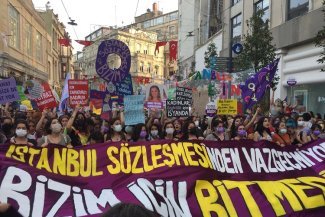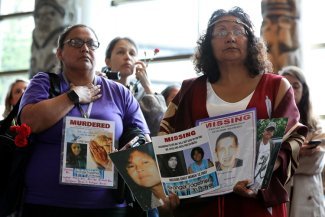A protest against gender-based violence targeted at women takes place in Madrid, Spain, on 11 June 2021. Spain adopted the first comprehensive law on gender-based violence in Europe in 2004.
Growing up in Costa Rica, Montserrat Sagot witnessed her mother be psychologically and verbally abused by her father as a teenager. The violence had a devastating effect on her mother and on Sagot’s own well-being. Even as a teenager, the situation felt unjust to her.
As an adult, Sagot decided to concentrate on gender-based violence and femicide – the killing of women, girls and non-binary people on account of their gender – in her work as a sociologist. In the 1990s, together with researcher and feminist activist Ana Carcedo, Sagot pioneered the first study on femicide in Costa Rica, which became the first country to pass a law making femicide a legally defined crime in 2007.
Fifteen years later, many countries around the world still have not adopted laws criminalising the most extreme form of gender-based violence; and women, girls and non-binary people continue to be killed at increasing rates because of their gender despite year-on-year fluctuations. Sagot has clear ideas on why: “Gender-based violence is systemic; it is an essential component of the racist and heteropatriarchal capitalism. And as long as the system does not change, the conditions in which femicides take place won’t either.”
At the end of 2021, the Global 16 Days campaign of the Center for Women’s Global Leadership (CWGL) at Rutgers University in the US launched a petition calling on the United Nations to declare 6 December as the International Day to End Femicide. On that day in 1989, a man killed 14 women at the University of Montreal, blaming them for his failure to gain entrance to the university’s engineering program – an event that came to be known as the Montreal Massacre.
The CWGL launched the petition to denounce impunity, raise awareness and demand government action so that no woman would ever be killed again because she is a woman. The petition had 2,014 signatures at the time of publication.
“The idea of the 16 Days campaign was to raise awareness about violence against women, but 30 years down the road what we see is that there may be more awareness, but there isn’t the level of accountability that is needed. The bottom line is women’s lives are not recognised,” says Melissa Upreti, CWGL’s senior director of programme and global advocacy. “We feel that having a day focused on femicides is needed to increase mobilisation of effort to demand an end to violence against women and girls, and to its underlying causes [of] discrimination and misogyny.”
Feminist activists contacted by Equal Times were nevertheless divided on the usefulness of the initiative. “I believe 25 November is powerful enough,” says Montserrat Vilà Planas, president of the Barcelona-based Unitarian Platform Against Gender-Based Violences. Every year, 25 November marks the International Day for the Elimination of Violence Against Women and commemorates the killing of Patria, Minerva and Maria Teresa Mirabal, three sisters who fought against the Trujillo dictatorship in the Dominican Republic during the late 1950s. “Campaigns like the 16 Days are good, but I think that if we distinguish between different forms of violence on different days, we might disperse forces,” Vilà Planas says.
Femicide, a global phenomenon
Estimating the global prevalence of femicide is a challenge: no homogeneous definition of the phenomenon exists, and most figures only account for female homicides by intimate partners or family members. It is therefore unsurprising that a 2021 report by the United Nations Office on Drugs and Crime (UNODC) describes the majority of femicides as being perpetrated by current or former husbands or intimate partners, with women having previously experienced non-lethal violence in the vast majority of cases.
Whether in public or private, in the domestic or labour sphere, the killing of women, girls and non-binary people because of their sex and gender is a global phenomenon. According to the 2021 UNODC report, a woman or girl was killed by someone in their family every 11 minutes in 2020. According to a 2021 report from the European Parliament that also relied on UNODC data, Africa is the continent with the highest rate of femicides relative to the size of its female population.
Data on other forms of femicides are mostly lacking, further complicating comparisons. This includes women killed after being raped, sexual or dowry-related femicides, the deliberate killing of female foetuses or new-born females, forced abortion of female foetuses, murder as a result of ‘corrective rape’ toward LGBTI people, genital mutilation, organised-crime related femicides, and the targeted killing of women in armed conflicts.
In the world of work, domestic workers are among the most potentially vulnerable to violence and abuse. “The major difficulty they face has to do with an ambiguity, a policy tension. They perform their jobs in private households and because of the overlap between work and the private space, oftentimes they are not protected by legislation on domestic violence,” says Roula Seghaier, a Tunisian-Russian feminist writer based in Lebanon and the strategic programme coordinator of the International Domestic Workers Federation. “On the other hand, in those countries where domestic work is not recognised as such, they are also not protected by legislation which protects workers within employment relations.”
“Moreover, the most conventional definitions of femicides do not have a labour component, so they have not thought of workers who perform jobs that are manual, precarious or within the informal economy as a population that is particularly vulnerable,” Seghaier says, though she adds this is slowly starting to shift. She mentions the International Labour Organization’s Convention 190 as an example of this trend. Having entered into force in 2021, it was the first international treaty to recognise the right of everyone to a world of work free from violence and harassment, including gender-based violence.
Change needed at all levels
According to the European Parliament’s report, Algeria is the African country with the lowest femicide rates. It also experienced the greatest drop in femicides between 2010 and 2019 of any African country. But Narimene Mouaci Bahi, an Algerian feminist activist based in Spain, says these numbers only tell half the story. “The figures of female homicides in Algeria only refer to big cities and only to voluntary manslaughter, so of course they are small,” she says, explaining that the term femicide is not legally defined as such in the country. “Moreover, there is a contradiction between the constitution, which clearly defends equality between men and women, and a family code that treats women as minors. And there is an important gap in the press coverage of the topic, [which] sometimes even blames the victims.”
Mouaci Bahi and fellow activist Wiame Awres launched the website Féminicides Algérie at the beginning of 2020 with the goal of documenting femicide cases in the North African country and keeping the issue in the spotlight. It is the only website to track the phenomenon in Algeria. “We do a daily search in the press for stories of female homicides and carry out research by talking to the family, journalists and so on. Only when we are sure about the fact that it is a femicide and about the details, we publish the info on our website,” she explains.
The description for the thirteenth woman to be killed in Algeria this year reads as follows: “On 16 April 2022, in El Oued, a woman in her thirties was murdered by her spouse, who burned her alive in front of two of her children. She was a mother of four.” When asked whether she sees signs for hope in the fight against femicides, Mouaci Bahi mentions the country in which she is currently based as evidence that progress is possible. “Here, there is political recognition and effective prevention policy,” she says.
It is a view echoed by Graciela Atencio, an Argentinian journalist also based in Spain and founder of the civil society observatory Feminicidio.net.
“Here when people know of a femicide case, they take to the streets. In my opinion, Spanish feminism is one of the strongest in the world and this has been reflected in public policies,” she says.
In spite of the limitations of data on femicides, existing figures seem to support Atencio and Mouaci Bahi’s views. According to the UNODC data, Europe is the continent with the lowest rate of femicides per female population, and Spain one of the countries where the number of intentional homicides targeting women has decreased the most between 2014 and 2019. According to the governing body of the country’s Ministry of Equality, the number of femicides at the hands of partners or former partners has decreased with around 50 percent since the adoption of the Integral Law on Gender-based violence in 2004. It was the first comprehensive law on gender-based violence to be adopted in Europe – it addresses preventive, educational, social, welfare, health and criminal aspects – and involves seven ministries.
But laws are just one avenue, according to the Costa Rica-based sociologist Sagot. “Changes are needed at all levels. Since we are talking about a multicausal phenomenon, it is useless to improve the judicial system if gender socialisation continues to produce defenceless women and violent men,” she explains. “On the other hand, it is useless to change gender socialisation if there is no good state response, and if the police does not respond for example when women ask for help.”













